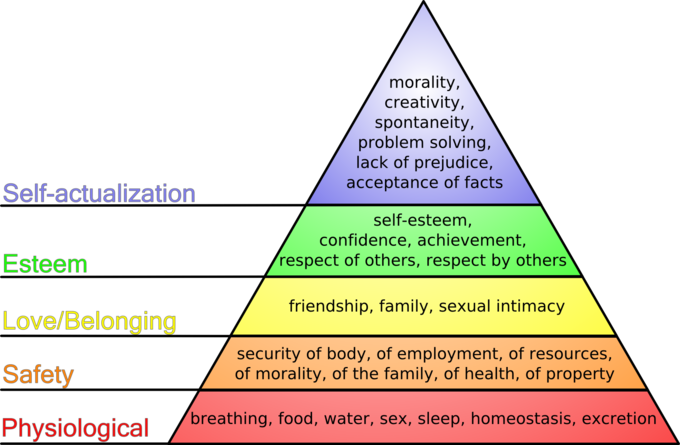Maslow hierarchy of needs
(Created page with ""missing graph" Maslow was born in the 1920s, Jew, lived in America. His work was pioneer in psychology because it looked at positive rather than negative facet of human beha...") |
|||
| Line 1: | Line 1: | ||
| − | + | [[File:Maslow's hierarchy of needs.png|frameless|center|1000px]] | |
Maslow was born in the 1920s, Jew, lived in America. His work was pioneer in psychology because it looked at positive rather than negative facet of human behaviour. | Maslow was born in the 1920s, Jew, lived in America. His work was pioneer in psychology because it looked at positive rather than negative facet of human behaviour. | ||
| Line 62: | Line 62: | ||
*Growth needs: self-actualisation | *Growth needs: self-actualisation | ||
*And suggests that people can go not only up but also down the hierarchy (regression) | *And suggests that people can go not only up but also down the hierarchy (regression) | ||
| + | aph" | ||
Revision as of 09:00, 10 August 2017
Maslow was born in the 1920s, Jew, lived in America. His work was pioneer in psychology because it looked at positive rather than negative facet of human behaviour.
He argues that ‘Man is a wanting animal and rarely reaches a state of complete satisfaction except for a short time. As one desire is satisfied, another pops up to take its place' [Maslow, 1943]
He proposes five levels of needs ordered in a hierarchy of needs. Once the requirements of a level is met on an on-going basis their needs move to the next level up.
Implications for project management
- Until the basic needs are met, an individual will not be looking for higher order needs.
- Motivation can be provided through an individual pursuing as yet unmet needs
Description
- Basic physiologic needs are the basic things the body needs to survive, lie air, water food, vitamins, etc.
- Safety and security: need to feel save, stability, protection: here it is the market explored by e.g. insurance, private security, but also home market
- Social needs: need for belonging, to love and give love, affection, friendship.
- Self-esteem: Lower: recognition, pride, power, glory, attention, reputation; Higher: self-respect. Achievement, competence
- Self-actualisation: need for growth, wisdom
Basic assumptions and principles of the model
- Climb the ladder –you need the basic before you can move up
- Individuals have an innate desire to move up
- A satisfied need is not a motivator: if you already have safety and security, further safety and security are not going to motivate you
- Self-actualisation is the only need that cannot be fully satisfied
- When needs are not satisfied, they can affect mental health, e.g. no self-esteem, inability to create relationship with others –depression
First four are the D-needs, deficit needs –you don’t miss water until you don’t have it. So this are not mechanism to motivate
They are basic needs, so what Maslow says is that we develop through them since we were babies. Deprivations early phases canmake us feel as if we would not have enough of a certain aspect. For example. Lost of a parent, is then developed into the formofextra need for love and social needs than usual. These are neurosis. We can also have regressions, as some of the basic needs are not attended.
Self-actualisation is a B-need, being need, need for growth: Be all you can be, exploit your potential
Maslow studied biographies of very enlighten people like Thomas Jefferson, Albert Einstein, Abraham Lincoln, and tried to understand the aspects of self-realisation
He noted that those people were:
- Happy about themselves, they accepted what they were, and did not change it to comply
- They also accepted others with their advantages and disadvantages
- They were problem solvers, they saw also their own limits as problems to be improved and did not blame past or other people for it.
- Autonomy, and ability to stay alone –rather few good deep friendships
- Freshness, simplicity, ability to see even ordinary things with wonder
- He developed the hierarchy of needs to explain why it –these people were at the ‘self-actualisation’ level.
Important criticism
- Different culture have different order in the hierarchy, e.g. social before security
- There is no evidence that people attempt to satisfy one level at the time only
- The hierarchy itself is complicated, how can this explain the starving musician?
- Problem with the methodology –picking a couple of people he defined as self-actualisation not really scientific!
- It does not predict behaviour
- If people would not perform if they cannot feel save, how can we think of performance in today’s context?
Variation: Alderfer’s ERG Theory
- Based on Maslow
- But, condenses the five levels into three:
- Existence needs: equivalent to physiological, safety and security
- Relatedness needs: social needs, affiliation, status, fun at work
- Growth needs: self-actualisation
- And suggests that people can go not only up but also down the hierarchy (regression)
aph"
